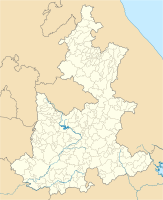Cholula de Rivadavia
| Cholula de Rivadavia | ||
|---|---|---|
|
Coordinates: 19 ° 4 ′ N , 98 ° 18 ′ W Cholula de Rivadavia on the map of Puebla
|
||
| Basic data | ||
| Country | Mexico | |
| State | Puebla | |
| Municipio | San Pedro Cholula | |
| Residents | 87,897 (2010) | |
| City insignia | ||
| Detailed data | ||
| height | 2146 m | |
| Post Code | 72760 | |
| prefix | (+52) 222 | |
| Time zone | UTC −6 | |
| City Presidency | José Juan Espinosa | |
| Website | ||
| Capilla Real by Cholula de Rivadavia | ||
Cholula de Rivadavia (originally Nahuatl Cholollan ; Cholula for short , often after the name of the municipality of San Pedro Cholula ) is a city with almost 90,000 inhabitants in the Mexican state of Puebla . Cholula de Rivadavia is located approx. 15 km west of the city center of Puebla at 2,146 m above sea level at the foot of the Popocatépetl volcano . Due to the large population growth of Puebla, Cholula de Rivadavia is now part of the Puebla metropolitan area.
The nickname Rivadavia refers to the figure of the independence movement of Argentina and the first president of this country, Bernardino Rivadavia , and was originally given to the district in his honor, a political unit that no longer exists.
Cholula de Rivadavia is the capital of the Municipio San Pedro Cholula . Sometimes there is confusion even among locals, as San Pedro Cholula has a neighboring municipio called San Andrés Cholula with the capital of the same name, San Andrés Cholula , which forms a conurbation with Cholula de Rivadavia. About 20 kilometers to the southwest there is also a smaller town called Santa Isabel Cholula .
Cityscape and sights
The arcades around the Zócalo of Cholula de Rivadavia are among the longest in Mexico. They house small cafes and shops. From here you can see the small city park and the 49 domes of the famous Capilla Real (16th century) of the former monastery of San Gabriel .
Before the Conquista, Cholula was a popular pilgrimage destination, with numerous temples, monasteries and pyramids. One of the largest pyramids ever built, the Great Pyramid of Cholula , located in the San Andrés Cholula area, has been preserved to this day and is still one of the largest sacred buildings in the world.
Despite the Conquista, Cholula has remained a holy city because it has 38 churches, which according to legend have 365 domes together. The church of Nuestra Señora de los Remedios towers over the city. The most important churches in Mexico also include Santa María Tonantzintla and San Francisco Acatepec in the area of San Andrés Cholula. Both are outstanding examples of the Mexican baroque.
history
Cholula was an important settlement in pre-Columbian times. People probably settled here well before 200 BC. Birth of christ.
Between 725 and 1525 AD, Cholula was an important spiritual center in the high valley of Mexico. Besides other sanctuaries, Cholula also housed the most important place of worship of the deity Quetzalcoatl , who was initially connected by the Aztecs to the person of the later conqueror, Cortes. Until the 16th century, Cholula, like the neighboring states of Tlaxcala and Huejotzingo, preserved independence from the Aztec empire . At the time of the arrival of the Spaniards in Central America, the city had over 100,000 inhabitants and had just become tributary to Tenochtitlan.
At the beginning of October 1519 the Spaniards reached the city and were received rather unfriendly by the population. The Spanish learned from native priests that a force was approaching from Tenochtitlan and that an ambush was being planned. The same was confirmed by a resident of the city who turned to Malinche , Hernán Cortés ' interpreter . After Spanish soldiers discovered the erection of barricades in the streets of Cholulas, they carried out a pre-emptive strike against the inhabitants of the city, in which the Tlaxcalteks also took part, killing many residents of the enemy city. Then Cortés ordered the surviving caciques of the city to bring back the people who had fled and to reopen the markets. The exact reasons that led Cortés to this massacre can no longer be clearly identified based on current sources.
Very soon after the Spanish conquest of Mexico, Cholula received the title of city on October 27, 1535 and a few years later a European city coat of arms.
The city grew relatively fast, but never reached the importance of nearby Puebla.
sons and daughters of the town
- Vicente T. Mendoza (1894–1964), musicologist and folklore researcher
literature
- Cholula in: Microsoft Encarta
- Bernal Díaz del Castillo : History of the Conquest of Mexico. Insel-Verlag, Frankfurt / M. 1988, ISBN 3-458-32767-3 .
- Hugh Thomas : The Conquest of Mexico, Cortes and Montezuma. Fischer Taschenbuch, Frankfurt / M. 2000 ISBN 3-596-14969-X
- Hans Dollinger : Black Book of World History. 5000 years man is the enemy of man. Pawlak Verlag, Herrsching 1973, ISBN 3-88199-030-5 .
Individual evidence
- ^ Spiegel Online - Cholula: The oldest city in Mexico
- ^ David Marley: Wars of the Americas , ABC-CLIO, 1998, ISBN 1-57607-504-4 . Page 18 ( preview in Google Book Search), accessed on October 18, 2010.
- ^ Bernal Díaz del Castillo: History of the Conquest of Mexico , 1988, p. 222.


